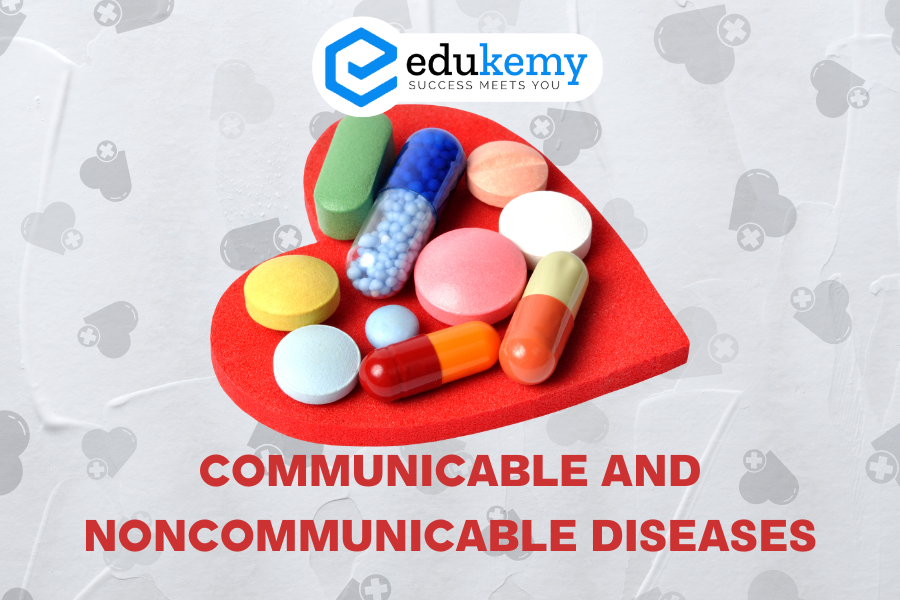
Communicable and noncommunicable diseases represent two distinct categories of illnesses that affect human health in various ways. Communicable diseases, also known as infectious diseases, are illnesses caused by pathogens such as bacteria, viruses, parasites, or fungi, which can be transmitted from one person to another through direct or indirect contact. These diseases often spread through bodily fluids, respiratory droplets, contaminated food or water, or vectors such as mosquitoes or ticks. On the other hand, noncommunicable diseases (NCDs) are typically chronic conditions that are not caused by infectious agents and cannot be transmitted from person to person. Instead, they often develop over time due to factors such as genetics, lifestyle choices, environmental influences, and underlying health conditions. Examples of noncommunicable diseases include cardiovascular diseases, cancer, diabetes, chronic respiratory diseases, and mental health disorders. Understanding the distinctions between communicable and noncommunicable diseases is crucial for effective prevention, diagnosis, and management strategies in public health initiatives worldwide.
| Communicable, HIV/AIDS and Noncommunicable diseases | In 2020, total number of patients notified for TB was 18,12,151. Out of the total microbiologically confirmed cases (8,43,149 in 2020) of TB, 76% of the patients were successfully treated. With state-wise fluctuations, India has made significant progress in tackling the HIV epidemic, from a prevalence of 0.80% in 2003 to 0.24% by 2018-19. In 2021, out of 5.91 crore people screened under the National Programme for Prevention and Control of Cancer, Diabetes, Cardiovascular Diseases and Stroke (NPCDCS): 7.6% were diagnosed with hypertension, 5.93% with diabetes, 2.49% with Hypertension and Diabetes, 0.255% with CVDs, 0.11% with stroke and 0.19% with common cancers. |
FAQs
1. What are Communicable Diseases?
- Communicable diseases are illnesses caused by infectious agents or pathogens such as bacteria, viruses, parasites, or fungi that can be transmitted directly or indirectly from one person to another, through contact with bodily fluids, contaminated surfaces, or vectors like mosquitoes.
2. How do Communicable Diseases Spread?
- Communicable diseases spread through various modes such as direct contact (person-to-person), airborne transmission (droplets in the air), ingestion of contaminated food or water, or through vectors like mosquitoes, ticks, or animals carrying infectious agents.
3. What are Examples of Communicable Diseases?
- Examples include influenza, HIV/AIDS, tuberculosis, malaria, COVID-19, measles, hepatitis, and sexually transmitted infections (STIs) such as chlamydia and gonorrhea.
4. What are Noncommunicable Diseases (NCDs)?
- Noncommunicable diseases are medical conditions that are not directly transmitted from one person to another. They are typically chronic in nature and develop over time due to a combination of genetic, environmental, and lifestyle factors.
5. What are Examples of Noncommunicable Diseases?
- Examples include cardiovascular diseases (such as heart disease and stroke), cancer, chronic respiratory diseases (like chronic obstructive pulmonary disease or asthma), diabetes, and mental health disorders like depression and anxiety.
In case you still have your doubts, contact us on 9811333901.
For UPSC Prelims Resources, Click here
For Daily Updates and Study Material:
Join our Telegram Channel – Edukemy for IAS
- 1. Learn through Videos – here
- 2. Be Exam Ready by Practicing Daily MCQs – here
- 3. Daily Newsletter – Get all your Current Affairs Covered – here
- 4. Mains Answer Writing Practice – here

